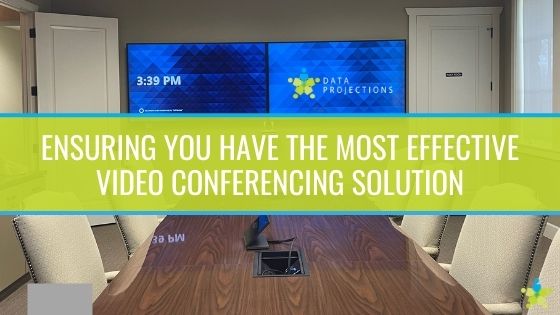[vc_row][vc_column][vc_column_text]
What does an effective video conferencing solution include?
With more people working and learning from home than ever before, video conferencing has become a must have for most businesses and schools. Identifying and integrating the best video conferencing solution, though, is a challenge. At the minimum, an effective video conferencing system should offer the following:- Excellent audio and video quality - When it comes to audio and video quality, good enough is not enough. People are quickly frustrated by a muddy picture or unclear audio, so quality cannot be compromised.
- Ease of use - The widespread adoption of video conferencing means people of all skill levels are expected to get comfortable with the technology. Modern conferencing systems are designed with this in mind, with uncomplicated controls and functionality.
- Reliability and intercompatibility - Today’s video conferencing systems are expected to be available close to 100 percent of the time. Another expectation: effective video conferencing solutions should be able to facilitate calls, no matter what platform the other party is using. To meet these expectations, you’ll need a professionally designed solution that is integrated by a reputable AV integrator.
What are some popular video conferencing options for standard conference rooms?
Current generation video conferencing solutions can be designed for any room, no matter its size, composition or layout. When choosing a system, though, room size is an important consideration, so here’s what a video conferencing solution might look like, depending on room size:[/vc_column_text][vc_column_text css=".vc_custom_1633712290587{padding-right: 40px !important;padding-left: 40px !important;}"]Small meeting spaces -
Along with video conferencing, smaller meeting spaces like focus rooms and huddle rooms are also becoming more common. With a modest footprint, organizations can add more of them to their building and allow for small teams to quickly meet and collaborate. In these spaces, an all-in-one video bar makes sense. Several top AV manufacturers, including Poly and Crestron, produce them and they represent some of the easiest conferencing solutions to install and manage. Video bars combine a high quality, smart camera, high quality speakers and a microphone, so the only other piece of hardware you’ll need is a display. Industry leading video bars, like Poly’s Studio X series, are also designed with noise reduction features and dual display support, which enhance the potential of your meetings. For example, with dual displays, your teams can conference with one screen and share content on another, which drives better collaboration. Video bars are simple to use, as they utilize familiar connectivity protocols like HDMI and USB and come with one-button call functionality for starting a meeting immediately.[/vc_column_text][vc_column_text css=".vc_custom_1633712337751{padding-right: 40px !important;padding-left: 40px !important;}"]Medium and large meeting spaces -
In larger conference rooms, an all-in-one video bar won’t be enough. In most cases, the best option is to put together a full-room solution, but the integration process is more complicated. With a room solution, the video conferencing components (camera, microphones, speakers, displays) are all installed separately. This ensures there is adequate video and audio coverage throughout the space. Though they require additional expertise, room systems allow integrators to customize the system’s technologies and arrangement, so organizations can fine tune their system to attain the best possible conferencing experience. For example, if your conference space has a small table, ceiling microphones can free up work space. If your conference room is more like an auditorium, switching out a standard microphone for a beamforming array will optimize audio quality. If your space is a traditional large conferencing room and if your organization relies on video conferencing for important communication, then an immersive telepresence solution may represent the best solution. Immersive telepresence is exactly how it sounds - the conference is designed to be as immersive as possible. This is made possible with multiple displays, cameras and microphones integrated into the ceiling or furniture. The technology is invisible but facilitates a seamless meeting without any need for manual control.[/vc_column_text][/vc_column][/vc_row][vc_row][vc_column][vc_column_text]Considering video conferencing? Work with a certified integrator!
No matter what your video conferencing needs are, a certified integrator should be the one to design, install, configure and maintain the technology. This is why:- A certified integrator can design a system to any fit - AV integrators are experts in system design and installation, so no matter what an organization’s conferencing needs are, a certified integrator will design a solution to fit. If, for instance, your organization is already familiar with Microsoft Teams, Zoom or another ecosystem, then an AV integrator will design a system that’s compatible.
- A certified integrator will ensure efficient, reliable installation - Without the proper expertise, it’s likely that problems will emerge during installation. Perhaps older system components need to be removed first. Maybe the room’s acoustics are interfering. The system may be obtrusive after installation. Whatever the issue, certified integrators are aware of them and know how to avoid or mitigate them. This will ensure that your conferencing solution is integrated on time and on budget.
- A certified integrator can provide long term support - Expert AV integrators serve as ongoing technology partners for many of their clients, and for good reason. Through an extended maintenance agreement, an integrator will monitor system performance, provide preventative maintenance, respond to any technical issues, ship and receive equipment for repair, resolve warranties, and more. With this long term support in place, professionally installed and maintained solutions will perform better and last longer. Also, a certified AV integrator will train its clients on system usage following installation. Training is designed with the audience’s skill level in mind, so your teams will know exactly what they need to know to operate the conferencing system properly.
- A certified integrator brings an expert opinion to AV decisions - AV is a complex field, and every AV-related decision is a challenge for organizations without a certified integrator helping out. With an integrator, though, your school or business will be well-informed about all things AV, including what technologies to target for the future, and how to get the most out of your organization’s current tech.



